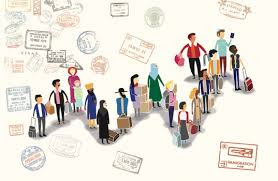Climate Change And Its Influence On Migration
Migration is caused by people moving in search of better conditions in life. These conditions can be economic, political, religious or other ‘life’ conditions.
Directly, flooded cities in coastal areas or dried out areas inland would be inhospitable and cause people to abandon the said areas and move elsewhere.
Island countries especially in the Pacific and Carribean are under threat from rising sea waters both directly and indirectly. Land acreage is being lost to the sea and freshwater aquifers are being invaded by sea water threatening even agriculture.
As noted, food insecurity and conflicts arising from over exploitation of increasingly scarce natural resources lead to migration.
Climate change is also a major factor fuelling or compounding other existing problems with its tentacles spreading to national and regional geopolitics. What do I mean?
Well, imagine a long unexpected drought in
State/Country A. Food reserves are running out, it’s too hot, wildfires, human-
wildlife conflict, rivers dry up, resources, capacity and personnel are
overstretched. The incumbent administration is caught flat footed and maybe
voted out of office.
Partly because of a human – induced natural calamity that
they had no idea would happen or persist that long and didn’t therefore plan
adequately for it.
Now, what if this aforementioned state or country is an important one, economically, security wise or for other strategic reasons? There is likely to be regime changes, democratically done or otherwise.
Climate change is a contributor to conflict, upheaval and geopolitical realignments.
 |
| Passports |
Let’s come back to this our beautiful Africa. Most African countries, in fact, the large majority do not experience the four season cycle, common in other parts of the world. What we have is the dry and rainy season, cold and hot months.
Let me recap something I mentioned in
one of the earlier articles. 6 out of the 10 most affected countries by climate
change are in Africa. If for example, South Sudan experiences a long drought, the pastoralist communities together with their animals cross over to neighboring countries in search of water and pasture.
Here, they will come into contact with the local communities who will naturally be very welcoming, but to a point. There then ensues a struggle for resources, which is a source of conflict. This is further compounded by other communities migrating into the same area.
Let’s zero in further, home in. What happens when Ethiopia, which is already facing drought, misses out on the required amounts of annual rainfall? That means that the Omo River goes down in terms of volume and/or maybe dry out.
The Jade
Sea, that jewel of the desert, Lake Turkana, shrinks in size therefore
putting in jeopardy the livelihoods of the hundreds of thousands of people and
wildlife that depend on that beautiful diamond of a lake.
This is also the case when pastoralist communities invade land farmed by agricultural communities or ranches.
This results to conflict, especially in election years.
Also, people escaping increasingly harsh environmental conditions naturally move or buy into areas in cooler climes. This leads to a higher
concentration of people in areas that would not be able to support the numbers.What
I have explained to you there is the truth, a likely scenario, a painful
alternative reality if we do not take action right now.
Climate change aggravates human wildlife conflict and the latter would lose out as protected wildlife areas are rapidly invaded by human beings.
Migration caused by climate change results in actions that further fuel global warming, such
as people invading forested areas, cutting down trees and thus causing
emissions from forest degradation and deforestation and partly LULUCF.
Environmental degradation and climate change have a complex relationship, with both being causative factors and effects of each other. For example,
1) Cutting down forested areas (for agriculture or human settlement) or drilling for oil in sensitive ecological areas like the Amazon is environmental degradation. Both actions lead to emissions of greenhouse gases which causes climate change
2) A rapidly changing climate would cause hitherto rainy areas to receive markedly lesser precipitation. As we all know, water is life. Water supports every living thing in this planet. High temperatures lead to dry rivers and lakes, a degraded environment. Also unpredictable weather patterns would cause animals and people to move to where water, as a scarce resource, is found in whatever quantities. Such areas will as a matter of fact undergo degradation.
Now, it is worth noting that the ways in which - and effects of - climate change cannot be fully predicted. We can only prepare for what we know.
As a planet, we need to wake up and drive the
change that we so desperately need for the climate.
We need to take care of what we have in order to avert a migration crisis, and conflict.





Comments
Post a Comment